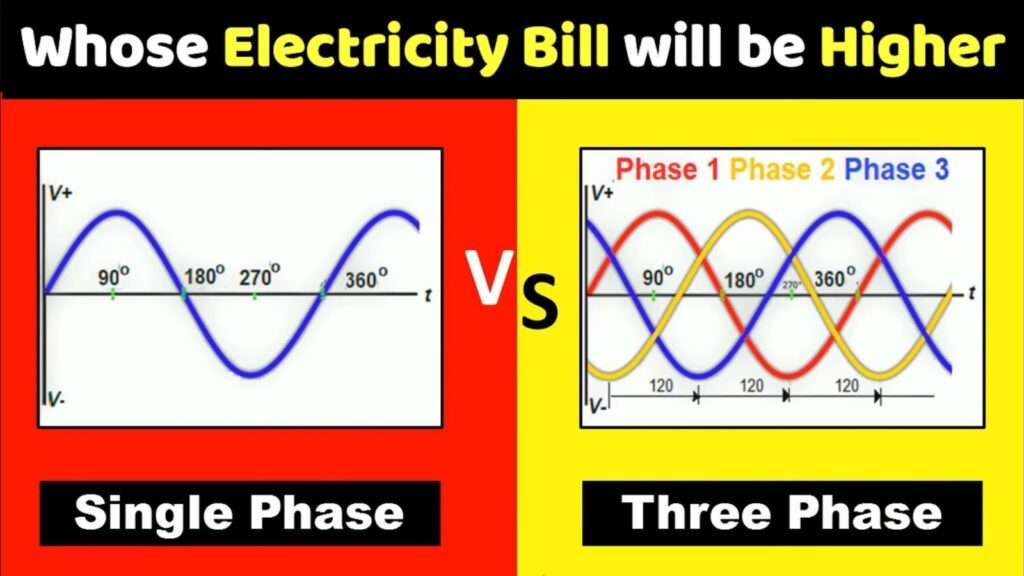Power Consumption in Single Phase and Three Phase
Introduction
When comparing electrical devices that run on single-phase and three-phase power supplies, one common question arises: Which one results in a higher electricity bill? Many people assume that three-phase power is more efficient, but does it actually reduce electricity consumption? Let’s find out.

Understanding Electricity Bills
To determine the cost of electricity consumption, we need to understand how an electricity bill is calculated. The energy meter measures power consumption in kilowatt-hours (kWh).
- 1 kWh (kilowatt-hour) = 1 unit of electricity
- If a 1000-watt (1 kW) device runs for 1 hour, the energy meter records 1 unit.
- A 2000-watt (2 kW) device running for 30 minutes also consumes 1 unit.
This means that electricity billing is based on total power consumption (kWh), regardless of whether the supply is single-phase or three-phase.
Power Consumption in Single Phase vs. Three Phase
Consider two identical 1000-watt heaters—one operating on a single-phase power supply and the other on a three-phase supply. If both run for 1 hour, their energy consumption will be:
- Single-phase heater: 1 kWh (1 unit)
- Three-phase heater: 1 kWh (1 unit)
Since both devices consume the same power over the same period, their electricity bills will be the same.
Current Consumption in Single Phase and Three Phase
Although power consumption remains the same, current draw (amperage) differs due to voltage variations in single-phase and three-phase systems.
Power Formula
For power calculations, we use the formulas:
- Single-phase power: P=V×I×PF
- P = Power (Watts)
- V = Voltage (Volts)
- I = Current (Amps)
- PF = Power Factor (usually 0.8 for resistive loads)
- Three-phase power: P=1.732 × V × I × PF
Using these formulas, let’s calculate the current drawn by a 1000-watt heater in both cases:
Single-Phase Current Calculation
Given:
- Power (P) = 1000W
- Voltage (V) = 230V
- Power Factor (PF) = 0.8
Solving for I (current): I=P / V×PF=1000/ 230×0.8=5.43A
Three-Phase Current Calculation
Given:
- Power (P) = 1000W
- Voltage (V) = 415V (line voltage for three-phase systems)
- Power Factor (PF) = 0.8
Solving for I (current): I=P/ 1.732 ×V×PF=1000/ 1.73×415×0.8=1.73A
Key Observations
Power Consumption is the Same – Whether a heater runs on a single-phase or three-phase power supply, its total energy consumption remains 1 kWh per hour.
Current Draw is Different – The single-phase heater draws 5.43A, whereas the three-phase heater draws only 1.73A due to the higher voltage.
Electricity Bill is Unaffected by Phase Type – Since billing is based on total kWh, it does not matter whether the equipment operates on single-phase or three-phase power.
Conclusion
For devices with the same power rating, the electricity bill remains the same whether they operate on single-phase or three-phase power. The key difference is in the current draw, which is higher in single-phase and lower in three-phase systems. This is why three-phase power is preferred for high-power industrial applications—it reduces the strain on wiring and electrical components.
By understanding these concepts, you can make better decisions when selecting power supply configurations for your electrical equipment.
PowerConsumption #SinglePhase #ThreePhase #ElectricityUsage #EnergyEfficiency #ElectricalPower #PhaseDifference #HomeAppliances #IndustrialPower #ElectricLoad #VoltageSupply #CurrentFlow #PowerFactor #EnergySaving #ElectricalEngineering
